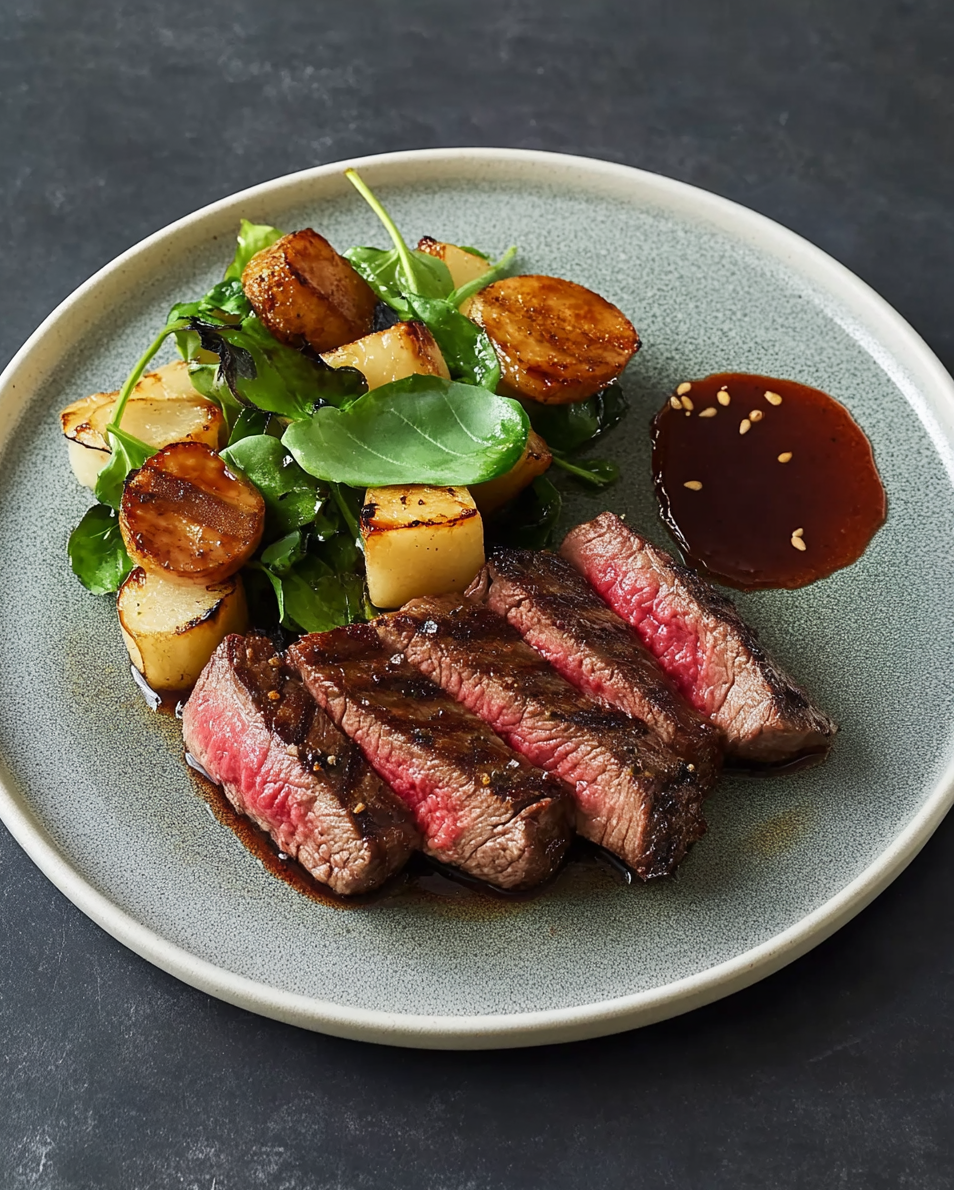The Japanese-Style Triple Seared Steak offers a tantalizing blend of rich umami flavors with every bite. The triple searing technique locks in the juices, creating a perfect crust on the outside while maintaining a tender, juicy interior. The combination of soy sauce, mirin, and sake infuses the beef with deep, savory notes, enhanced by the fresh zing of ginger and garlic.
This dish is ideal for a quick yet impressive dinner that brings the authentic flavors of Japanese cuisine right to your table. Whether served with a side of steamed rice, a fresh salad, or sautéed vegetables, this steak will undoubtedly be the star of your meal. Perfect for a special occasion or a gourmet weeknight treat, this recipe is sure to impress.
Full Recipe:
- 2 (8-ounce) beef steaks
- Salt and freshly ground black pepper to taste
- 1 tablespoon vegetable oil
- 2 tablespoons soy sauce
- 1 tablespoon mirin (Japanese sweet rice wine)
- 1 tablespoon sake
- 1 teaspoon grated ginger
- 2 cloves garlic, minced
- 2 green onions, sliced
- 1 tablespoon sesame oil
Directions:
- Season the steaks with salt and black pepper on both sides.
- Heat a skillet over high heat and add vegetable oil.
- Sear the steaks for about 1-2 minutes on each side until a crust forms, then remove from the pan and let rest.
- In the same skillet, combine soy sauce, mirin, sake, grated ginger, and minced garlic. Cook for 1-2 minutes, allowing the sauce to slightly thicken.
- Return the steaks to the skillet and sear each side for another minute, basting with the sauce.
- Remove the steaks from the skillet once again, add sesame oil to the pan, and quickly sear the steaks a final time, ensuring they are evenly coated with the sauce.
- Slice the steaks against the grain and garnish with sliced green onions before serving.
Prep Time: 10 minutes | Cooking Time: 10 minutes | Total Time: 20 minutes
Kcal: 450 kcal | Servings: 2 servings
The Essence of Japanese-Style Triple Seared Steak
The Japanese-Style Triple Seared Steak is a culinary masterpiece that embodies the elegance and simplicity of Japanese cuisine while delivering robust flavors that tantalize the palate. The process of triple searing not only enhances the texture of the steak but also deepens its flavor, making every bite a symphony of taste.
Understanding the Ingredients
- Beef Steaks: The choice of steak is crucial for this recipe. Opt for high-quality cuts like ribeye or sirloin, known for their tenderness and marbling. The marbling in the beef ensures that the steak remains juicy and flavorful even after multiple searing stages.
- Soy Sauce: This is the cornerstone of many Japanese dishes. It provides a salty, umami-rich base that complements the natural flavors of the beef.
- Mirin: A sweet rice wine that adds a subtle sweetness and depth to the marinade. Mirin balances the saltiness of the soy sauce, creating a harmonious blend of flavors.
- Sake: A traditional Japanese rice wine that adds complexity to the marinade. Sake tenderizes the meat and infuses it with a mild sweetness and a hint of acidity.
- Ginger and Garlic: These aromatics bring a fresh, zesty element to the dish, cutting through the richness of the steak and adding layers of flavor.
- Sesame Oil: Used in the final searing, sesame oil imparts a nutty, toasty flavor that enhances the overall dish, giving it a distinct Japanese flair.
Cooking Technique: The Art of Triple Searing
The triple searing technique is what sets this dish apart. Here’s why it’s so effective:
- First Sear: The initial sear creates a delicious crust on the steak, locking in the juices and forming the foundation of the dish’s texture.
- Second Sear with Sauce: By returning the steak to the pan after adding the sauce, the steak absorbs the soy-mirin-sake mixture, allowing the flavors to penetrate deeper into the meat.
- Final Sear with Sesame Oil: The final searing step, with the addition of sesame oil, not only enhances the flavor but also gives the steak a beautiful, glossy finish.
Serving Suggestions
This Japanese-Style Triple Seared Steak pairs wonderfully with a variety of sides:
- Steamed Rice: The simplicity of steamed white rice allows the rich flavors of the steak to shine. The rice also serves as the perfect base to soak up the savory sauce.
- Sautéed Vegetables: Lightly sautéed vegetables like bok choy, snap peas, or shiitake mushrooms complement the steak without overpowering it, adding a healthy and fresh element to the meal.
- Pickled Vegetables: Serve with Japanese pickles (tsukemono) to add a tangy contrast that cuts through the richness of the steak.
- Miso Soup: A bowl of miso soup can add warmth and comfort, making this meal even more satisfying.
Cultural Context
In Japanese cuisine, balance is key. This recipe exemplifies the Japanese approach to cooking, where each element is carefully considered to create harmony on the plate. The use of traditional ingredients like soy sauce, mirin, and sake not only adds flavor but also reflects the cultural significance of these staples in Japanese households. The technique of triple searing is a modern twist, giving the dish a unique character while staying true to the essence of Japanese culinary traditions.
Why This Recipe Works
The combination of quality ingredients, thoughtful cooking techniques, and a deep respect for flavor balance makes this Japanese-Style Triple Seared Steak a standout dish. Whether you’re a seasoned cook or a beginner, this recipe is approachable yet impressive, making it perfect for both weeknight dinners and special occasions.
Exploring the Origin and Influence
Culinary Background
The Japanese-Style Triple Seared Steak draws inspiration from the classic techniques and flavors of Japanese cuisine, particularly the emphasis on umami, the fifth taste that brings depth and richness to dishes. This recipe showcases the Japanese approach to cooking, where simplicity and precision are paramount.
While steak isn’t traditionally a staple in Japanese cuisine, the influence of Western culinary practices has led to the incorporation of beef dishes in modern Japanese dining. This recipe, with its combination of traditional Japanese ingredients and Western cooking methods, reflects the global influence on contemporary Japanese cuisine.
Ingredients in Detail
- Soy Sauce: Often referred to as “shoyu” in Japan, soy sauce is a fundamental ingredient in Japanese cooking. It’s made from fermented soybeans, wheat, and salt, and its complex flavor profile—salty, umami-rich, slightly sweet, and sometimes even bitter—forms the backbone of many Japanese dishes. In this recipe, soy sauce not only seasons the beef but also contributes to the creation of the sauce that coats the steak during the second sear.
- Mirin: This sweet rice wine is a type of rice vinegar with a higher sugar content and lower alcohol level than sake. Mirin’s sweetness balances the saltiness of soy sauce and enhances the umami flavor, making it an essential ingredient in Japanese marinades and glazes. It’s commonly used in dishes like teriyaki and tempura, and in this recipe, it adds a subtle sweetness that complements the savory steak.
- Sake: Sake, a traditional Japanese rice wine, is used both as a drink and as a cooking ingredient. It adds a mild, complex flavor with a slight sweetness and acidity that helps to tenderize the meat and enhance the overall flavor profile of the dish. Sake is often used in combination with soy sauce and mirin in Japanese recipes to create a balanced marinade or sauce.
- Ginger: Ginger is widely used in Japanese cooking for its fresh, spicy, and slightly sweet flavor. It adds a sharp, zesty note to the dish, which helps to cut through the richness of the beef and the umami flavors from the soy sauce and sake.
- Garlic: Though not traditionally a dominant ingredient in Japanese cuisine, garlic has found its way into many modern Japanese dishes, especially those with Western influences. In this recipe, garlic adds a robust flavor that complements the ginger and enhances the overall taste of the steak.
- Sesame Oil: Made from toasted sesame seeds, sesame oil is a flavorful finishing oil that’s often used in Asian cooking. Its nutty aroma and rich flavor make it the perfect final touch in the last searing step, adding depth to the dish and giving the steak a beautiful shine.
Cooking Technique: The Significance of Triple Searing
First Sear: Locking in the Juices
The initial sear is critical as it seals the surface of the steak, locking in the juices and creating a flavorful crust. This crust is formed through the Maillard reaction, a chemical process that occurs when proteins and sugars in the meat are exposed to high heat. This not only adds flavor but also creates a textural contrast between the crispy exterior and the tender interior.
Second Sear: Infusing the Flavor
The second sear is where the steak begins to absorb the rich flavors of the sauce. By returning the steak to the pan with the soy sauce, mirin, sake, ginger, and garlic, the meat soaks up these flavors, deepening its taste. This step is crucial for ensuring that every bite of the steak is infused with the signature Japanese flavors.
Final Sear: Adding a Nutty Finish
The final sear with sesame oil is the finishing touch that elevates the dish. The sesame oil adds a nutty, toasted flavor that complements the savory sauce and enhances the steak’s overall taste. This last sear also helps to caramelize the sauce, giving the steak a glossy, appetizing appearance.
Serving Suggestions and Pairings
Traditional Japanese Accompaniments
- Steamed White Rice: A staple in Japanese cuisine, steamed white rice serves as a neutral base that allows the flavors of the steak to stand out. It also helps to balance the richness of the dish.
- Miso Soup: Miso soup, made from fermented soybean paste, dashi (a Japanese stock), and tofu or seaweed, is a comforting and nutritious side that pairs well with the steak. The savory umami of the miso complements the flavors of the steak, creating a harmonious meal.
- Pickled Vegetables (Tsukemono): Pickles such as takuan (pickled daikon radish) or umeboshi (pickled plum) offer a tangy contrast that cuts through the richness of the steak. They also add a refreshing crunch to the meal.
Modern Fusion Ideas
- Wasabi Mashed Potatoes: For a fusion twist, consider serving the steak with wasabi mashed potatoes. The creamy texture and spicy kick of wasabi add an exciting contrast to the savory steak.
- Grilled Asparagus with Sesame Dressing: Lightly grilled asparagus drizzled with a sesame dressing makes for a healthy and flavorful side that pairs perfectly with the steak’s bold flavors.
- Sake Pairing: Serve the meal with a glass of chilled sake, choosing a type that complements the flavors of the dish. A light, dry sake will balance the richness of the steak, while a sweeter sake can enhance the umami flavors.
Cultural Significance and Modern Adaptations
The Role of Beef in Japanese Cuisine
Beef wasn’t always a common ingredient in Japanese cuisine, largely due to historical and cultural factors. However, in the Meiji period (late 19th century), Japan opened its doors to Western influences, and beef began to gain popularity. Today, dishes like sukiyaki and yakiniku (Japanese barbecue) showcase the Japanese adaptation of beef in their cuisine. The Japanese-Style Triple Seared Steak is a modern creation that continues this trend, combining traditional Japanese flavors with the Western love for a well-cooked steak.
Modern Adaptations and Global Influence
This recipe also reflects the global influence on Japanese cuisine. As Japanese chefs and home cooks continue to experiment with international ingredients and techniques, dishes like this one emerge, blending the best of both worlds. The triple searing technique is a nod to the meticulous nature of Japanese cooking, where attention to detail is key. At the same time, the use of beef and the incorporation of garlic highlight the Western influence that has been seamlessly integrated into modern Japanese cooking.
Conclusion: A Dish for All Occasions
The Japanese-Style Triple Seared Steak is more than just a recipe—it’s an experience. It’s a dish that showcases the beauty of simplicity in cooking, where a few high-quality ingredients, combined with careful technique, can create something truly special. Whether you’re cooking for a special occasion or simply want to treat yourself to a gourmet meal at home, this steak is sure to impress with its rich flavors and elegant presentation.






